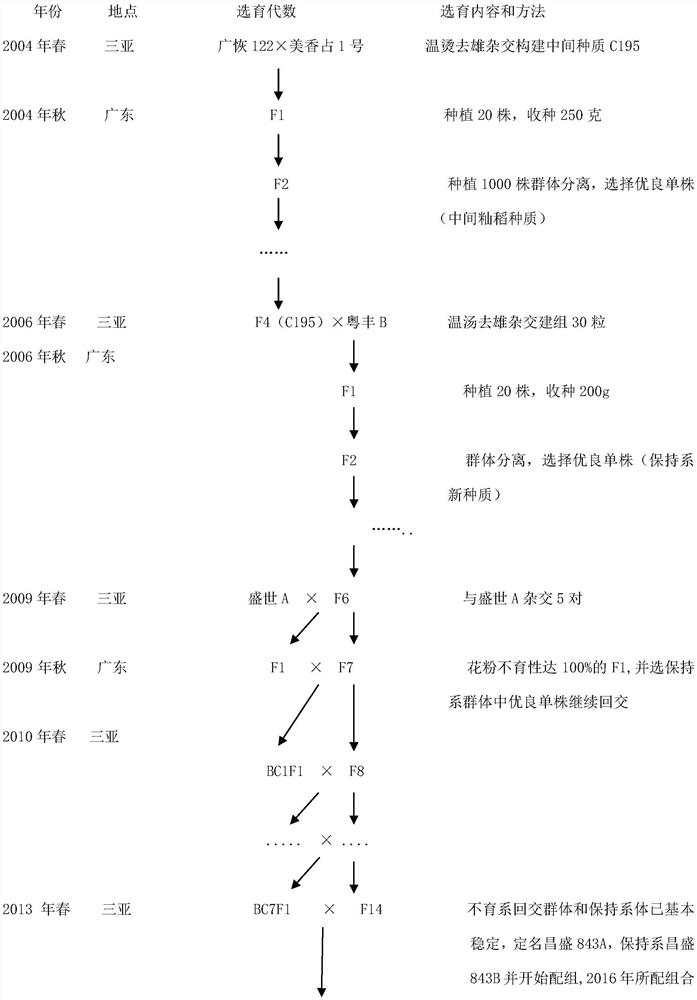Breeding method of three-line indica rice male sterile line of wild beating type
A wild-type, indica rice technology, applied in botany equipment and methods, plant gene improvement, application, etc., can solve the problems of poor fertility stability of sterile lines, difficulty in large-scale application, etc., to achieve good grouting and fading, resistance Strong reversibility and tidy heading effect
- Summary
- Abstract
- Description
- Claims
- Application Information
AI Technical Summary
Problems solved by technology
Method used
Image
Examples
Embodiment 1
[0020] The invention provides a method for breeding wild-type three-line indica male sterile lines, comprising the following steps:
[0021] (1) To construct an intermediate indica rice germplasm. In the spring of 2004 at the Sanya Breeding Base in Hainan, the high-quality, blast-resistant three-line restorer germplasm "Guanghui 122" was crossed with the high-quality conventional rice germplasm "Meixiangzhan No. 1". Directed breeding for 4 consecutive generations, bred an intermediate indica germplasm material with early growth period, slender grain shape, and fragrance, named "C195";
[0022] (2) In the spring of 2006, at the Sanya Breeding Base in Hainan, the maintainer line "Yuefeng B" bred by the Rice Research Institute of the Guangdong Academy of Agricultural Sciences was used as the female parent and the "C195" obtained in step (1) was crossed by warming and killing males , the descendants of which were selected and bred for 6 consecutive generations to form a new germpl...
Embodiment 2
[0025] The characteristics of the sterile line Changsheng 843A obtained in Example 1 were tested.
[0026] 1. Sterility
[0027] In the spring of 2017, 20 individual plants of the Changsheng 843A breeding population were inspected under the microscope at the Sanya Breeding Base in Hainan. The pollen sterility of the sterile line reached 100%, and the pollen was typically aborted; the fertility did not fluctuate with changes in the external temperature. The seed setting rate of bagging self-breeding was 0. In August 2017, the group microscopic examination results in Pingxiang, Jiangxi Province showed that 0.02% was stained, 5% was round, and 94.98% was lost. The specific results are shown in Table 1
[0028] Table 1
[0029]
[0030]
[0031] 2. Growth period characteristics
[0032] In the spring of 2017, it was sown in mid-January at the Sanya Breeding Base in Hainan, and the sowing period was 70 days.
[0033] In 2017, the seeds were sown in Pingxiang, Jiangxi on J...
Embodiment 3
[0046] Propagate the sterile line Changsheng 843A obtained in Example 1, as follows:
[0047] For Changsheng 843A in Jiangxi and Hunan, it is better to propagate in autumn. It is sown in mid-to-early June, and the female parent is sown 4-5 days earlier than the male parent. Seed amount for female parent: 37.5kg / hm 2, the amount of seed used in the male parent is 15kg / hm 2 . The breeding field is 1.7m open, and the ratio of male parent to female parent is 2:9. The male parent is planted in small double rows, the density is 16.5cm×23.3cm, and 3-5 seedlings are planted per stalk; the female parent’s transplanting leaf age is controlled within 4.3 leaves for early start, the density is 13.2cm×16.5cm, and each stalk Plant double copies.
[0048] Adopt full health care cultivation, control the amount of nitrogen fertilizer, and increase the application of phosphorus and potassium fertilizers. At the beginning of panicle differentiation, paclobutrazol 1.8kg / hm can be sprayed on ...
PUM
 Login to View More
Login to View More Abstract
Description
Claims
Application Information
 Login to View More
Login to View More - R&D
- Intellectual Property
- Life Sciences
- Materials
- Tech Scout
- Unparalleled Data Quality
- Higher Quality Content
- 60% Fewer Hallucinations
Browse by: Latest US Patents, China's latest patents, Technical Efficacy Thesaurus, Application Domain, Technology Topic, Popular Technical Reports.
© 2025 PatSnap. All rights reserved.Legal|Privacy policy|Modern Slavery Act Transparency Statement|Sitemap|About US| Contact US: help@patsnap.com



